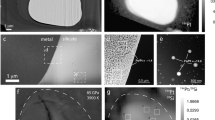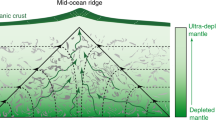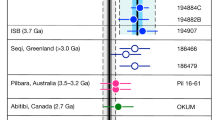Abstract
Core–mantle differentiation is the largest event experienced by a growing planet during its early history. Terrestrial core segregation imprinted the residual mantle composition by scavenging siderophile (iron-loving) elements such as tungsten, cobalt and sulphur. Cosmochemical constraints suggest that about 97% of Earth’s sulphur should at present reside in the core1, which implies that the residual silicate mantle should exhibit fractionated 34S/32S ratios according to the relevant metal–silicate partition coefficients2, together with fractionated siderophile element abundances. However, Earth’s mantle has long been thought to be both homogeneous and chondritic for 34S/32S, similar to Canyon Diablo troilite3,4,5,6, as it is for most siderophile elements. This belief was consistent with a mantle sulphur budget dominated by late-accreted chondritic components. Here we show that the mantle, as sampled by mid-ocean ridge basalts from the south Atlantic ridge, displays heterogeneous 34S/32S ratios, directly correlated to the strontium and neodymium isotope ratios 87Sr/86Sr and 143Nd/144Nd. These isotope trends are compatible with binary mixing between a low-34S/32S ambient mantle and a high-34S/32S recycled component that we infer to be subducted sediments. The depleted end-member is characterized by a significantly negative δ34S of −1.28 ± 0.33‰ that cannot reach a chondritic value even when surface sulphur (from continents, altered oceanic crust, sediments and oceans) is added. Such a non-chondritic 34S/32S ratio for the silicate Earth could be accounted for by a core–mantle differentiation record in which the core has a 34S/32S ratio slightly higher than that of chondrites (δ34S = +0.07‰). Despite evidence for late-veneer addition of siderophile elements (and therefore sulphur) after core formation, our results imply that the mantle sulphur budget retains fingerprints of core–mantle differentiation.
This is a preview of subscription content, access via your institution
Access options
Subscribe to this journal
Receive 51 print issues and online access
$199.00 per year
only $3.90 per issue
Buy this article
- Purchase on Springer Link
- Instant access to full article PDF
Prices may be subject to local taxes which are calculated during checkout


Similar content being viewed by others
References
Dreibus, G. & Palme, H. Cosmochemical constraints on the sulfur content in the Earth’s core. Geochim. Cosmochim. Acta 60, 1125–1130 (1996)
Shahar, A., Fei, Y., Liu, M. C. & Wang, J. Sulfur isotopic fractionation during the differentiation of Mars. Geochim. Cosmochim. Acta 73 (Suppl.). A1201 (2009)
Gao, X. & Thiemens, M. Isotopic composition and concentration of sulfur in carbonaceous chondrites. Geochim. Cosmochim. Acta 57, 3159–3169 (1993)
Gao, X. & Thiemens, M. Variations of the isotopic composition of sulfur in enstatite and ordinary chondrites. Geochim. Cosmochim. Acta 57, 3171–3176 (1993)
Sakai, H., Marais, D. J., Ueda, A. & Moore, J. G. Concentrations and isotope ratios of carbon, nitrogen and sulfur in ocean-floor basalts. Geochim. Cosmochim. Acta 48, 2433–2441 (1984)
Chaussidon, M., Sheppard, S. M. F. & Michard, A. Hydrogen, sulphur and neodymium isotope variations in the mantle beneath the EPR at 12°50’N. J. Geochem. Soc. 3, 325–337 (1991)
Labidi, J., Cartigny, P., Birck, J. L., Assayag, N. & Bourrand, J. J. Determination of multiple sulfur isotopes in glasses: a reappraisal of the MORB δ34S. Chem. Geol. 334, 189–198 (2012)
Douglass, J., Schilling, J. G. & Fontignie, D. Plume-ridge interactions of the Discovery and Shona mantle plumes with the southern Mid-Atlantic Ridge (40°-55°S). J. Geophys. Res. 104, 2941–2962 (1999)
Andres, M., Blichert-Toft, J. & Schilling, J. G. Hafnium isotopes in basalts from the southern Mid-Atlantic Ridge from 40°S to 55°S: discovery and Shona plume-ridge interactions and the role of recycled sediments. Geochem. Geophys. Geosyst. 3, 1–25 (2002)
Escrig, S., Schiano, P., Schilling, J. G. & Allègre, C. Rhenium-osmium isotope systematics in MORB from the Southern Mid-Atlantic Ridge (40°-50°S). Earth Planet. Sci. Lett. 235, 528–548 (2005)
Moreira, M., Staudacher, T., Sarda, P., Schilling, J. G. & Allègre, C. J. A primitive plume neon component in MORB: the Shona ridge-anomaly, South Atlantic (51–52°S). Earth Planet. Sci. Lett. 133, 367–377 (1995)
Sarda, P., Moreira, M., Staudacher, T., Schilling, J. G. & Allègre, C. J. Rare gas systematics on the southernmost Mid-Atlantic Ridge: constraints on the lower mantle and the Dupal source. J. Geophys. Res. 105, 5973–5996 (2000)
Dixon, J. E., Leist, L., Langmuir, C. & Schilling, J. G. Recycled dehydrated lithosphere observed in plume influenced mid-ocean-ridge basalt. Nature 420, 385–389 (2002)
le Roux, P. J. le Roex, A. P. & Schilling, J. G. MORB melting processes beneath the southern Mid-Atlantic Ridge (40–55°S): a role for mantle plume-derived pyroxenite. Contrib. Mineral. Petrol. 144, 206–229 (2002)
le Roux, P. J. et al. Mantle heterogeneity beneath the southern Mid-Atlantic Ridge: trace element evidence for contamination of ambient asthenospheric mantle. Earth Planet. Sci. Lett. 203, 479–498 (2002)
Mathez, E. A. Sulfur solubility and magmatic sulfides in submarine basalt glass. J. Geophys. Res. 81, 4269–4276 (1976)
Wallace, P. & Carmichael, I. S. E. Sulfur in basaltic magmas. Geochim. Cosmochim. Acta 56, 1863–1874 (1992)
Métrich, N., Berry, A. J., O’Neill, H. S. C. & Susini, J. The oxidation state of sulfur in synthetic and natural glasses determined by X-ray absorption spectroscopy. Geochim. Cosmochim. Acta 73, 2382–2399 (2009)
Dixon, J. E., Clague, D. A. & Stolper, E. M. Degassing history of water, sulfur, and carbon in submarine lavas from Kilauea Volcano, Hawaii. J. Geol. 99, 371–394 (1991)
Cabral, R. A. et al. Anomalous sulphur isotopes in plume lavas reveal deep mantle storage of Archaean crust. Nature 496, 490–493 (2013)
Kelley, K., Plank, T., Ludden, J. & Staudigel, H. Composition of altered oceanic crust at ODP Sites 801 and 1149. Geochem. Geophys. Geosyst. 4, 8910 (2003)
O’Neill, H. S. C. The origin of the Moon and the early history of the Earth—a chemical model. Part 2: The Earth. Geochim. Cosmochim. Acta 55, 1159–1172 (1991)
McDonough, W. F. Constraints on the composition of the continental lithospheric mantle. Earth Planet. Sci. Lett. 101, 1–18 (1990)
Rudnick, R. L. & Gao, S. Composition of the continental crust. Treat. Geochem. 3, 1–64 (2003)
Plank, T. & Langmuir, C. H. The chemical composition of subducting sediment and its consequences for the crust and mantle. Chem. Geol. 145, 325–394 (1998)
Poulton, S. W., Fralick, P. W. & Canfield, D. E. The transition to a sulphidic ocean 1.84 billion years ago. Nature 431, 173–177 (2004)
Canfield, D. E. & Farquhar, J. Animal evolution, bioturbation, and the sulfate concentration of the oceans. Proc. Natl Acad. Sci. USA 106, 8123–8127 (2009)
Farquhar, J., Bao, H. & Thiemens, M. Atmospheric influence of Earth’s earliest sulfur cycle. Science 289, 756–758 (2000)
Caro, G. & Bourdon, B. Non-chondritic Sm/Nd ratio in the terrestrial planets: consequences for the geochemical evolution of the mantle–crust system. Geochim. Cosmochim. Acta 74, 3333–3349 (2010)
Wedepohl, K. H. The composition of the continental crust. Geochim. Cosmochim. Acta 59, 1217–1232 (1995)
Righter, K., Humayun, M. & Danielson, L. Partitioning of palladium at high pressures and temperatures during core formation. Nature Geosci. 1, 321–323 (2008)
Bonifacie, M. et al. The chlorine isotope composition of Earth’s mantle. Science 319, 1518–1520 (2008)
Acknowledgements
Support from the Region Ile de France (Sesame), CNRS (INSU-Mi-lourd and SEDIT-CNRS) and IPGP (BQR) is acknowledged. We thank M. G. Jackson for a review. We thank D. Calmels and M. Clog for discussion and comments. We also thank P. Richet, M. Chaussidon and P. Agrinier for comments on an early version of the manuscript. This is IPGP contribution number 3415.
Author information
Authors and Affiliations
Contributions
J.L. performed sulphur isotope measurements. J.L. and M.M. performed sample preparation. P.C. conceived the project. J.L. took the lead in writing the paper, with substantial contributions from P.C. and M.M.
Corresponding author
Ethics declarations
Competing interests
The authors declare no competing financial interests.
Supplementary information
Supplementary Information
This file contains Supplementary Text, Supplementary References, Supplementary Table 1 and Supplementary Figures 1-6. (PDF 1012 kb)
Supplementary Data
This file contains the complete geochemical database for the studied samples. (XLS 136 kb)
PowerPoint slides
Source data
Rights and permissions
About this article
Cite this article
Labidi, J., Cartigny, P. & Moreira, M. Non-chondritic sulphur isotope composition of the terrestrial mantle. Nature 501, 208–211 (2013). https://doi.org/10.1038/nature12490
Received:
Accepted:
Published:
Issue Date:
DOI: https://doi.org/10.1038/nature12490
Comments
By submitting a comment you agree to abide by our Terms and Community Guidelines. If you find something abusive or that does not comply with our terms or guidelines please flag it as inappropriate.



